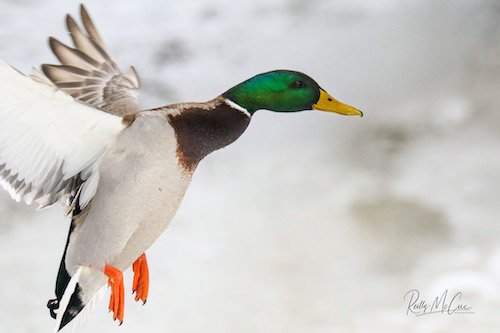Mallard
 The Mallard (Anas platyrhynchos) is the most iconic wild duck found in North America and, truthfully, throughout nearly the entire northern hemisphere. A large puddle duck, their luminous mallard-green heads are definitive. “Greenhead” even colloquially refers to either drakes, or drakes and hens both! Drakes also have the recognizable white collar directly under their green head and display the classic black-tail curl. Mallards have gray-brown wings with bright blue speculums, double white wing bars, with the top white wing bar extending into hen’s tertials. Non-breeding males have similar plumage to the females, but still have the bright yellow bill that breeding males display, while hens have an orange bill that increasingly mottle in adulthood. Hen vocalizations are the quacking gold standard of the duck hunting world. drakes make a quiet rasping buzz.
The Mallard (Anas platyrhynchos) is the most iconic wild duck found in North America and, truthfully, throughout nearly the entire northern hemisphere. A large puddle duck, their luminous mallard-green heads are definitive. “Greenhead” even colloquially refers to either drakes, or drakes and hens both! Drakes also have the recognizable white collar directly under their green head and display the classic black-tail curl. Mallards have gray-brown wings with bright blue speculums, double white wing bars, with the top white wing bar extending into hen’s tertials. Non-breeding males have similar plumage to the females, but still have the bright yellow bill that breeding males display, while hens have an orange bill that increasingly mottle in adulthood. Hen vocalizations are the quacking gold standard of the duck hunting world. drakes make a quiet rasping buzz.
Available Hunts
-
Wyoming Duck Hunt
Wyoming duck hunt at Mountain View Mallards entails plentiful mallards and Canada geese in one of the most stunningly beautiful parts of America. Hunt comfortably from heated blinds and enjoy the show.
...read more- Predominately mallards and Canada geese, other species seasonally
- Upscale, newly constructed 6-bedroom lodge, with excellent amenities
- 3 excellent chef-prepared meals daily, dinner feature beef
- December-January primetime
- Comfortable heated blinds, professional guide-staff
- For 2-6 hunters, maximum 12 guests
- Fly into Billings MT or Cody WY
Rate: $2,750 3-day package -
Wyoming Waterfowl Hunting
World-class hunting for mallards and Canada geese along the legendary North Platte River in Wyoming-Nebraska with long-time professional outfitter that has a proven track-record for success.
...read more- High-quality hunting experiences for mallards and BIG migrator Canada geese along legendary North Platte River
- Impressive 95% repeat-client bookings for past decade, completely sold out last 10 years
- Hunting eastern Wyoming and western Nebraska
- Professionally guided hunts, experienced guides, heated blinds, premier private properties
- Hotel accommodations and local meals available nearby
- Private air services within minutes, commercial air services in Denver (3 hours)
Rate: $2,100 (see details)
 Mallards are ubiquitous throughout the United States year-round. Migratory breeding zones in Alaska, Canada, some northern states, and even Eurasia. They are not picky eaters, and will consume available plant and animal matter in the water or on land. Diet while migrating is dominated by agricultural seeds/grain. During the wintering season, mallards can be found in the southern half of the U.S. and into Mexico. Habitat requirements for this species may be filled by any area that is remotely wet, whether it be permanent or ephemeral wetlands. They may also be found in suburban areas.
Mallards are ubiquitous throughout the United States year-round. Migratory breeding zones in Alaska, Canada, some northern states, and even Eurasia. They are not picky eaters, and will consume available plant and animal matter in the water or on land. Diet while migrating is dominated by agricultural seeds/grain. During the wintering season, mallards can be found in the southern half of the U.S. and into Mexico. Habitat requirements for this species may be filled by any area that is remotely wet, whether it be permanent or ephemeral wetlands. They may also be found in suburban areas.
The Mallard is responsible for most domestic duck breeds, except for the Muscovy duck, and has proven to be valuable in the wild and in domesticity. Wild North American mallard research has demonstrated “Old World” genetics in the Atlantic Flyway versus “New World” genetics in Central and Pacific Flyways, and may account for population and perceived migration trends. (Listen Now: Just a Mallard? Think Again).
Mallards are an extremely popular bird to hunt, making up 1 of every 3 birds shot in North America. There is nothing more American in duck hunting than the ever-popular mallard.







